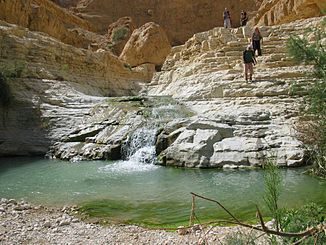Nachal Arugot
| Nachal Arugot | ||
|
Nachal Arugot in May 2006 |
||
| Data | ||
| location | Israel and West Bank | |
| River system | Nachal Arugot | |
| muzzle | into the Dead Sea Coordinates: 31 ° 27 '42 " N , 35 ° 23' 59" E 31 ° 27 '42 " N , 35 ° 23' 59" E |
|
| Height difference | 1400 m | |
| Bottom slope | 45 ‰ | |
| length | 31 km | |
| Wadi | ||
The Nachal Arugot ( Hebrew נַחַל עֲרוּגוֹת) is a west-east running wadi in Israel and the West Bank . It flows south of En Gedi into the Dead Sea and runs through a height difference of 1400 m. The three parts of the 31 km long wadis bear in Arabic the names Wadi el-Jihar , Wadi el-Ghar and Wadi Areijeh .
Archaeological finds
Due to its location in the Judean Desert , there were no permanent settlements along the Nachal, only seasonal Bedouin settlements and forts . Archaeological surveys revealed architectural remains and ceramics from the Iron Age , the Hellenistic and early Roman periods. In the Wadi el-Jihar there were monasteries from Byzantine times such as the Nea Laura , the Severianus monastery and Khirbet ed-Deir . Numerous graves with wooden coffins and wooden ossuaries were discovered at the mouth of the Nachal . A pitcher handle was found in one of the caves with the inscription "for Nachum, my slave" in ancient Hebrew script .
Leviticus scroll
In 2004 Bedouins from the Rashaidah tribe found four inscribed leather fragments in a small and inaccessible cave in Nachal Arugot. The cave belongs to a group of four caves that are located under a large waterfall on the southern edge of the Nachal. Ceramics and textiles from the time of the Bar Kochba uprising were also found in them. Initially, the fragments were photographed in August 2004 by Roi Porat, a student of Hanan Eshel from Bar-Ilan University . Since the purchase of ancient scrolls of unclear origin is prohibited by law in Israel in order to restrict the illegal trade in antiques, Eshel initially refused to buy the fragments from the Bedouins. With financial support from the Jeselsohn Epigraphic Center of Jewish History , the fragments were finally acquired in March 2005. Two of the fragments had since been put together, perhaps by the Bedouins or an antique dealer. For Eshel and Porat, however, the purchase had legal consequences.
Fragment A measures approximately 3.5 x 3.5 cm. It contains the top of a scroll as well as the remains of four lines of text. These can be described as Leviticus 23.38f. identify. Fragments B and C measure approximately 6 x 5.5 cm. The text received is divided into two columns , with 8 lines from the right and 5 lines from the left. The text of the right column contains Lev 23,40-44, that of the left column Lev 24,16-19. The fourth fragment consisted of different layers. With the help of infrared examinations, the remains of letters could be identified. However, separating the layers did not help deciphering and assigning the tiny fragments. Lines and column margins are drawn out with a pointed object. A reconstruction of the role shows that each column should have contained 36 lines. The writing can be dated palaeographically to the time after the destruction of the temple in 70 AD. The text only differs from the Masoretic text in one single case (Lev 23.4) in the plene spelling . Interestingly, this spelling is used in the Babylonian Talmud in the Sukkah tract for a halachic interpretation.
Paleography and archaeological find context suggest that the scroll was brought into the cave during the time of the Bar Kochba uprising. It is the first biblical scroll found at the Dead Sea since 1962.
literature
- Hanan Eshel, Yosi Baruchi, Roi Porat: Fragments of a Leviticus Scroll (ArugLev) Found in the Judean Desert in 2004 . In: Dead Sea Discoveries 13 (2006), 55-60.
- Gideon Hadas: Arugot, Naḥal . In: Encyclopedia of the Dead Sea Scrolls , ed. LH Schiffman, JC VanderKam . Oxford 2000, 67-68.
- Yizhar Hirschfeld : The Judean Desert Monasteries in the Byzantine Period . London and New Haven 1992. ISBN 0-300-04977-3
Web links
Individual evidence
- ^ Questioning a Scientist's True Intentions. Haaretz , August 12, 2007.

